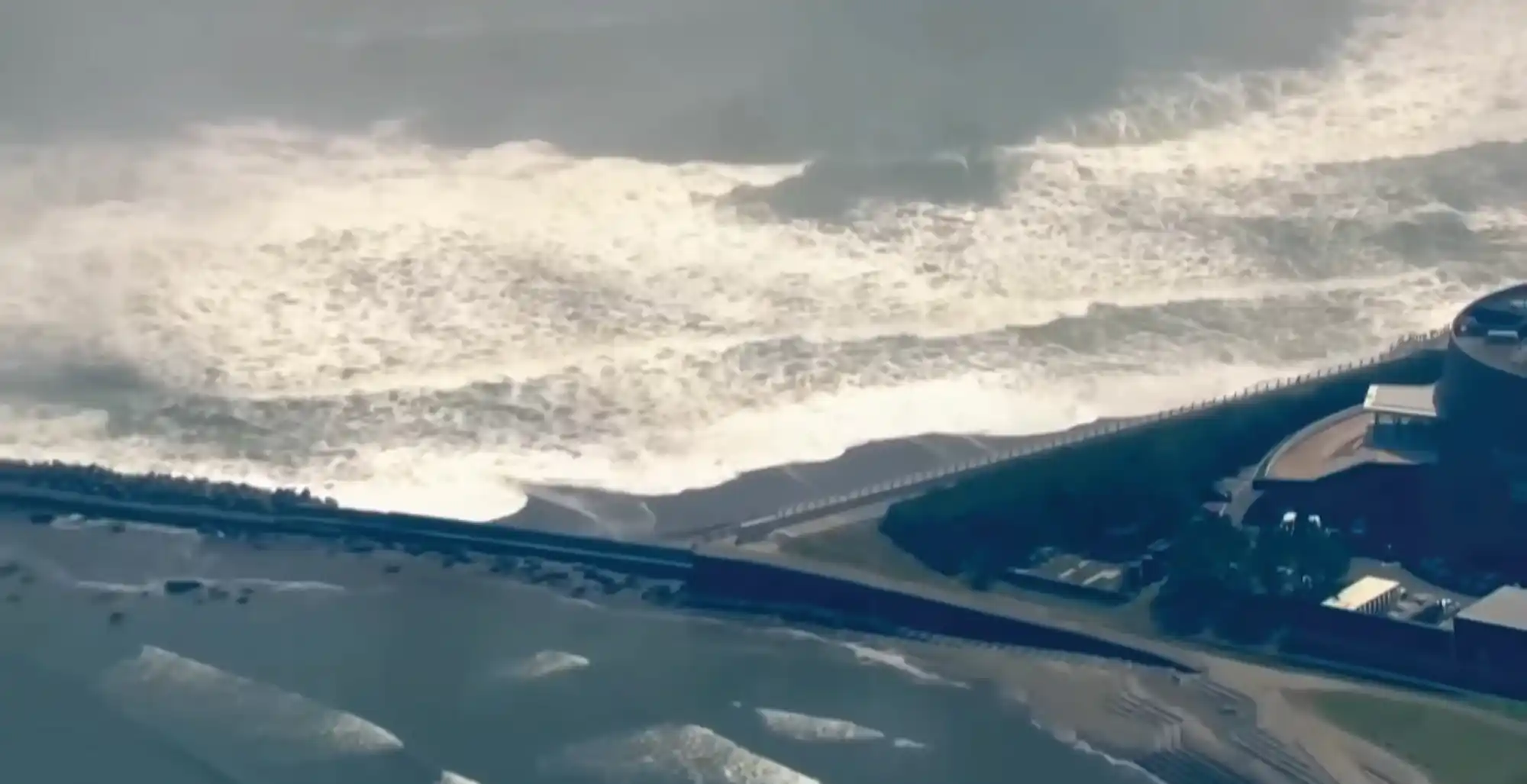A powerful seismic event has sent shockwaves across the Pacific Ocean, prompting emergency responses from Hawaii to California and affecting millions of people across multiple nations. The magnitude of this natural disaster has drawn comparisons to some of the most devastating earthquakes in recent history, with authorities scrambling to assess damage and ensure public safety as the situation continues to develop.
The Seismic Event That Shook the Pacific
The Associated Press confirmed that a massive 8.8-magnitude earthquake struck approximately 75 miles off the Russian city of Petropavlovsk-Kamchatsky on the Kamchatka Peninsula. The underwater quake, which occurred at a depth of 13 miles, has been identified as the most powerful earthquake recorded since the catastrophic 9.0 Tōhoku earthquake that devastated Japan in March 2011.
The earthquake’s positioning beneath the Pacific Ocean floor created the perfect conditions for tsunami generation. When tectonic plates shift dramatically underwater, they displace enormous volumes of water, creating waves that can travel thousands of miles across ocean basins at speeds approaching 500 miles per hour. The energy released by this particular earthquake was sufficient to generate tsunami waves that would eventually reach coastlines across the entire Pacific Rim.
Seismologists have noted that earthquakes of this magnitude are relatively rare, occurring perhaps once every few years globally. The 8.8 reading places this event among the most powerful earthquakes ever recorded, joining an exclusive list of mega-quakes that have shaped our understanding of geological forces and their potential for widespread destruction.
Hawaii Bears the Initial Impact
As the tsunami waves radiated outward from their Russian origin point, Hawaii found itself directly in their path. The island chain, located roughly in the center of the Pacific Ocean, often serves as an early indicator of tsunami severity for other Pacific coastal regions.
Fox Weather reported that the waves struck Hawaiian shores with varying intensities across different locations. Kahului, located on the island of Maui, experienced the most severe impact with wave amplitudes reaching 5.7 feet above normal sea levels. This measurement represents the difference between the tsunami wave height and typical ocean conditions, making it a critical metric for assessing potential damage and danger to coastal communities.
The island of Hawaii’s eastern shore also felt significant impact, with Hilo recording wave amplitudes of 4.9 feet. Hilo’s location and geography make it particularly vulnerable to tsunami damage, as the city sits in a bay that can amplify incoming waves. Historical precedent shows that Hilo has suffered devastating tsunami damage in the past, making any tsunami warning in this area particularly concerning for residents and authorities.
Other Hawaiian locations experienced varying degrees of impact, with Haleiwa recording 4-foot wave amplitudes and Hanalei measuring 3.9-foot amplitudes. These measurements, while lower than those recorded in Kahului and Hilo, still represented significant departures from normal ocean conditions and posed potential risks to coastal infrastructure and beachfront properties.
The response from Hawaiian authorities was swift and comprehensive. For several hours, the entire state remained under tsunami warnings, with coastal evacuation orders in effect across multiple counties. The decision to maintain warnings reflected the unpredictable nature of tsunami waves, which can arrive in multiple sets over several hours, with later waves sometimes proving more dangerous than initial ones.
Hawaii County officials eventually made the decision to cancel evacuation orders for coastal zones, allowing residents to return to their homes. However, this decision came with important caveats – officials urged returning residents to remain vigilant and cautious of possible damage to infrastructure, utilities, and property that might not be immediately visible.
West Coast Under Siege
The tsunami waves continued their relentless journey eastward across the Pacific, eventually reaching the continental United States’ West Coast in the early hours of Wednesday morning. The states of California, Oregon, and Washington all reported tsunami activity, though the wave heights generally decreased as they traveled further from their source.
California bore the brunt of the West Coast impact, with Crescent City – a community that has historically been vulnerable to tsunami damage due to its geographical position – recording wave amplitudes of 3.6 feet. This measurement was particularly significant given Crescent City’s tragic history with tsunamis, including devastating damage from the 1964 Alaska earthquake and tsunami.
Arena Cove, another California coastal location, experienced tsunami waves with amplitudes reaching 3 feet. These waves, while smaller than those recorded in Hawaii, still represented potentially dangerous conditions for anyone in coastal areas, including beachgoers, fishermen, and residents of waterfront properties.
Further south along the California coast, Point Reyes and Monterey reported more moderate but still notable wave amplitudes of 1.6 feet and 1.4 feet, respectively. These measurements suggested that the tsunami’s energy was beginning to dissipate as it spread across the vast Pacific, but coastal areas remained under advisory conditions as authorities monitored the situation.
CNN reported that as conditions evolved throughout the day, only a small portion of Northern California’s coast remained under the more serious tsunami warning designation. The majority of the U.S. West Coast, including the Oregon and Washington coastlines, transitioned to tsunami advisory status as wave heights generally remained below one foot in amplitude.
Global Response and Impact
The earthquake’s effects extended far beyond the immediate tsunami zones, with Japan – a nation with extensive experience in tsunami preparedness and response – taking extraordinary precautionary measures. NBC News reported that more than 1.9 million people across 207 cities throughout Japan were evacuated as a precautionary measure, demonstrating the country’s commitment to protecting its citizens based on lessons learned from the devastating 2011 Tōhoku disaster.
Japan’s response reflected the nation’s sophisticated tsunami warning system and evacuation protocols, developed and refined over decades of dealing with seismic threats. The decision to evacuate nearly two million people across such a wide area underscored both the potential severity of the threat and Japan’s unwillingness to take chances with public safety.
As conditions stabilized and the immediate threat diminished, Japanese authorities eventually downgraded all tsunami warnings to advisory status, allowing evacuated residents to return to their homes and communities. This systematic approach to threat assessment and response demonstrated how nations can effectively manage tsunami risks through comprehensive planning and public education.
Russian Epicenter and Effects
At the earthquake’s source, Russian authorities and media outlets provided updates on conditions around the Kamchatka Peninsula. CNN, citing Russian media sources and Kremlin officials, reported that remarkably, no casualties were recorded in Russia despite the earthquake’s tremendous magnitude and proximity to populated areas.
However, the absence of reported casualties did not mean the region escaped unscathed. NBC News, referencing Russian media reports, indicated that tsunami waves reaching heights of 10 feet were recorded along the Kamchatka Peninsula coastline. Even more dramatically, some areas off the Russian coast experienced waves as high as 13 feet, representing potentially catastrophic conditions for any vessels or coastal infrastructure in the affected areas.
The relatively low population density of the Kamchatka Peninsula likely contributed to the absence of reported casualties, as fewer people and structures were directly exposed to the earthquake and tsunami effects compared to more densely populated coastal regions elsewhere in the Pacific.
Scientific Significance and Historical Context
This earthquake and resulting tsunami event provides valuable scientific data for researchers studying seismic activity and tsunami propagation across the Pacific Basin. The 8.8 magnitude reading places this earthquake among the most powerful ever recorded, offering scientists an opportunity to study the mechanics of mega-earthquakes and their far-reaching effects.
The comparison to the 2011 Tōhoku earthquake is particularly significant, as that event fundamentally changed global understanding of tsunami risks and response protocols. The Tōhoku disaster, with its 9.0 magnitude, generated tsunami waves that reached heights of over 130 feet in some areas and traveled up to six miles inland, causing unprecedented destruction and loss of life.
While this latest earthquake was slightly smaller in magnitude, its generation of Pacific-wide tsunami activity demonstrates the ongoing seismic activity that characterizes the “Ring of Fire” – the horseshoe-shaped zone of frequent earthquakes and volcanic eruptions that surrounds the Pacific Ocean.
Ongoing Monitoring and Recovery
As authorities across the Pacific continue to assess the full impact of this seismic event, the focus has shifted from immediate emergency response to damage assessment and recovery planning. Coastal communities are conducting surveys of infrastructure, utilities, and property to identify any damage that may have occurred during the tsunami’s passage.
The event serves as a reminder of the Pacific Ocean’s potential for generating far-reaching natural disasters and the importance of maintaining robust tsunami warning systems and emergency response protocols. The relatively successful management of this crisis, with minimal reported casualties despite the earthquake’s tremendous power, demonstrates the value of international cooperation in disaster preparedness and response.
For residents of Pacific coastal communities, this event reinforces the ongoing importance of understanding tsunami risks, maintaining emergency preparedness supplies, and staying informed about evacuation procedures and warning systems that could prove life-saving in future seismic events.

Ethan Blake is a skilled Creative Content Specialist with a talent for crafting engaging and thought-provoking narratives. With a strong background in storytelling and digital content creation, Ethan brings a unique perspective to his role at TheArchivists, where he curates and produces captivating content for a global audience.
Ethan holds a degree in Communications from Zurich University, where he developed his expertise in storytelling, media strategy, and audience engagement. Known for his ability to blend creativity with analytical precision, he excels at creating content that not only entertains but also connects deeply with readers.
At TheArchivists, Ethan specializes in uncovering compelling stories that reflect a wide range of human experiences. His work is celebrated for its authenticity, creativity, and ability to spark meaningful conversations, earning him recognition among peers and readers alike.
Passionate about the art of storytelling, Ethan enjoys exploring themes of culture, history, and personal growth, aiming to inspire and inform with every piece he creates. Dedicated to making a lasting impact, Ethan continues to push boundaries in the ever-evolving world of digital content.
